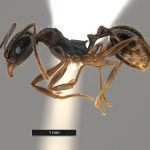 Aphaenogaster picea image provided by www.AntWiki.com
Aphaenogaster picea image provided by www.AntWiki.com Dark reddish-brown to dark blackish-brown, mandibles and apical four segments of antennae slightly paler, legs often distinctly paler (light to dary yellowish-brown but often darkened, but fore coxae, at least, nearly concolorous with alitrunk); head with moderately fine rugose/reticulate sculpture plus very finely punctate, moderately glossy, alitrunk with some faint rugae but mostly with smooth punctate sculpture, largely glossy, katepisternum especially smoothed, with central glossy area. This species complex is another member of the fulva-picea-rudis complex. Ohio material studied by the present authro has consistently been identified using the characters in the key. Note especially the bicolored antennae, usual darker coloration, and moderately reduced sculpturing, with the katepisternum normally having a smoothed, glossy area anteriorly. Most easily confused with A. rudis, which has unicolored antennae, and paler legs and coxae which contrast with the somewhat darker alitrunk.
Colonies often moderately large.
The name “picea” means pitch-black or black with a slight red tinge. Indeed this species is usually darker in color than the relater A. rudis. A complex of two sibling species differentiated by chromosome number; one or possibly both are found in Ohio. Very often a conspicuous element of Ohio woodlands.
Size
Nuptial Flight Dates
Habitat
Food
Behavior
Nesting Information
Verified Locales (counties)
Ashland, Astabula, Belmont, Champaign, Clark, Clinton, Columbiana, Coshocton, Crawford, Cuyahoga, Fairfield, Fulton, Geagua, Greene, Hardin, Harrison, Highland, Hocking, Holmes, Jackson, Jefferson, Knox, Lake, Lawrence, Licking, Logan, Lucas, Mahoning, Medina, Miami, Monroe, Montgomery, Morgan, Morrow, Noble, Ottawa, Perry, Pike, Portage, Preble, Richland, Ross, Scioto, Stark, Summit, Trumbull, Tuscarawas, Vinton, Warren, Washington, Wayne, Woods,


